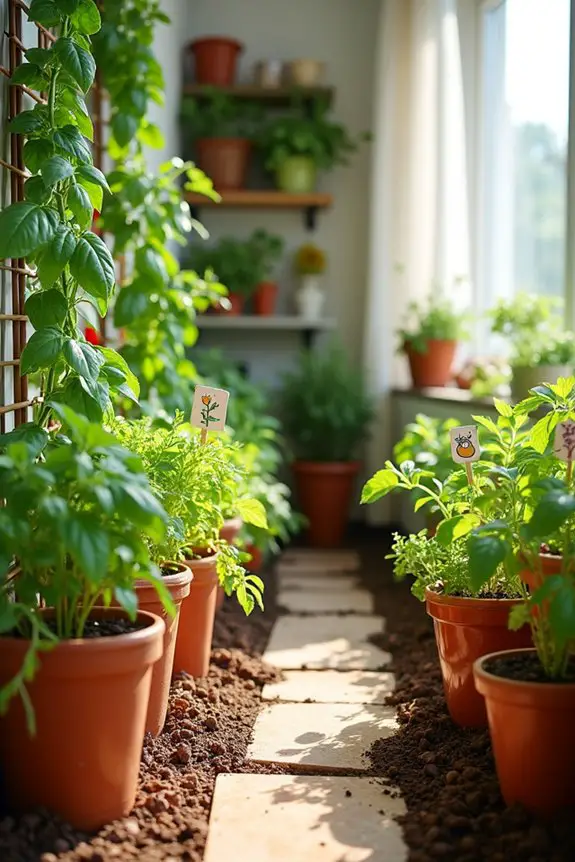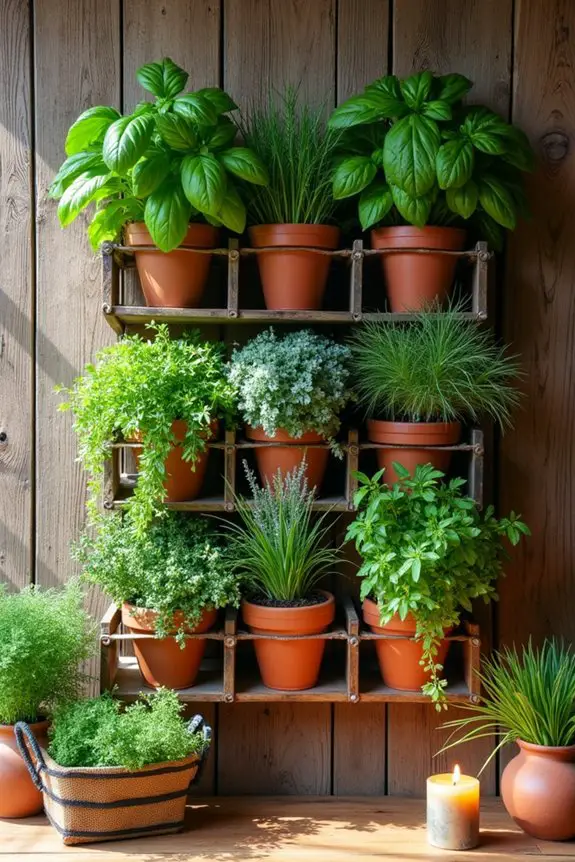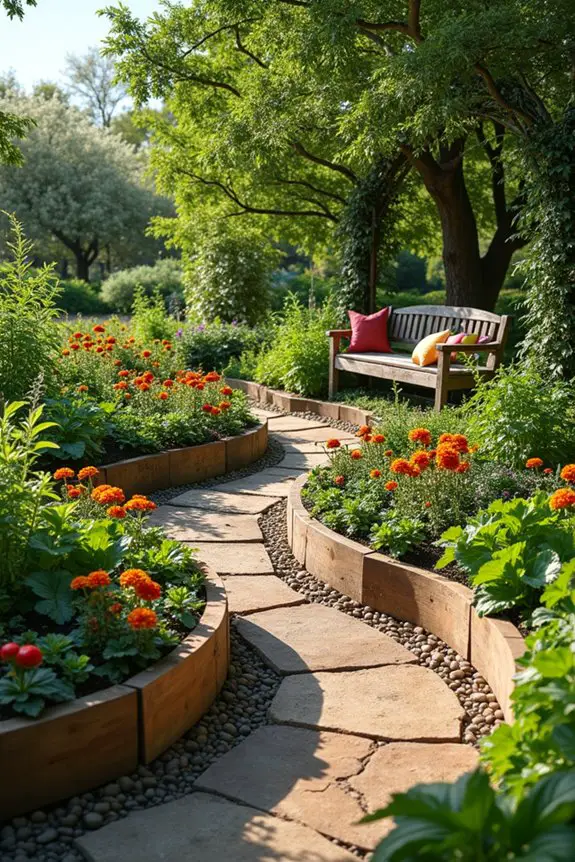So, you’ve got a veggie garden, huh? That’s awesome. But maybe it needs a little sprucing up, or maybe you’re just itching to try something new. Imagine raised beds, vertical trellises, or colorful pots bursting with life. It’s like cooking—pick your ingredients wisely, and you’ll whip up something amazing. Trust me, a little creativity can turn your ordinary patch into something extraordinary. Curious about what designs can really elevate your gardening game? Let’s explore.
Indoor Vegetable Garden Layout
Creating an indoor vegetable garden layout can be a fun challenge, don’t you think? Imagine turning that little corner of your kitchen into a vibrant herb spiral or arranging your plants so they practically high-five as they grow upwards on a vertical trellis.
With a bit of planning on bed arrangements and selecting the right plants for those tricky spots, you’ll not only maximize your space, but you’ll also make your space feel like a cozy, green oasis.
1. Herb Spiral for Space Efficiency
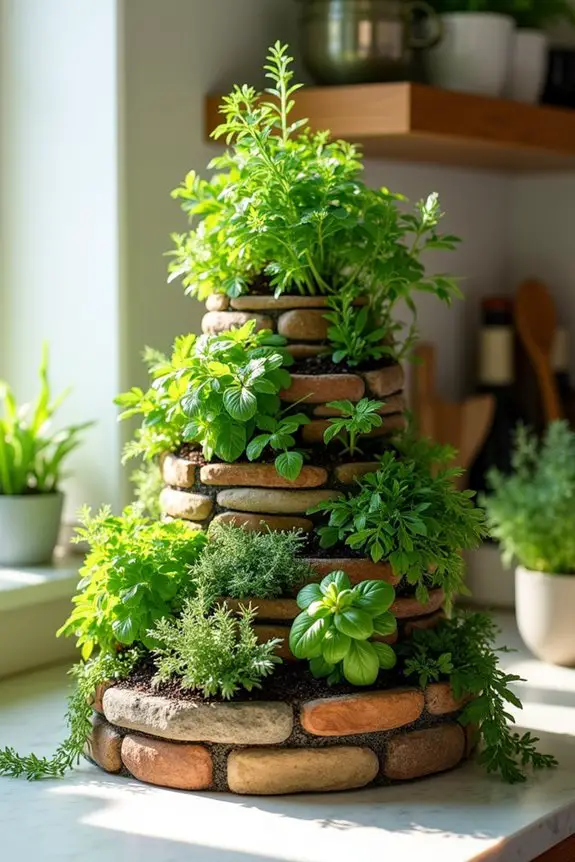
When it comes to making the most out of your indoor space, the herb spiral stands out as a brilliant solution. It’s not just a clever use of vertical gardening; it also offers easy access to fresh herbs and a stunning visual element that can spark joy in any kitchen.
Imagine a spiraled arrangement of aromatic delights, with basil, thyme, and mint all thriving in harmony. How can you resist that?
To create your own herb spiral, start with a small space—one that you can easily reach from your kitchen. Gather some stones or bricks to form a spiral shape, wider at the bottom and narrowing at the top. You want it to resemble a snail shell because, let’s be real, who doesn’t love cute snail references in their garden?
Layer your spiral with good quality soil, mixing in some compost to give your herbs a nutrient boost. A fertilizer injector(fertilizer-injector) can further enhance the nutrient delivery to your plants, ensuring they flourish in this vibrant setup. Now, plant your herbs, placing the sun-loving varieties, like rosemary and oregano, at the top, where they’ll receive the most light. Meanwhile, you can tuck those moisture-loving herbs, like parsley and cilantro, at the bottom. It’s like giving each herb its special spot to shine!
Don’t forget to water your herb spiral! With that design, the spiral shape not only looks great, but it helps with drainage too, as the water naturally flows down the slope. So, you’ll be spending less time worrying about overwatering and more time dreaming up delicious recipes. Plus, consider integrating a vertical garden wall planter for even more space efficiency and greenery in your kitchen.
In all honesty, a little mess is inevitable—dirt under your nails, soil on the floor. But hey, that’s just part of the adventure.
Just picture yourself snipping fresh herbs for a pasta dish or a revitalizing salad. You’ll feel like a kitchen rock star, and your friends will be totally impressed.
2. Garden Bed Arrangement Tips
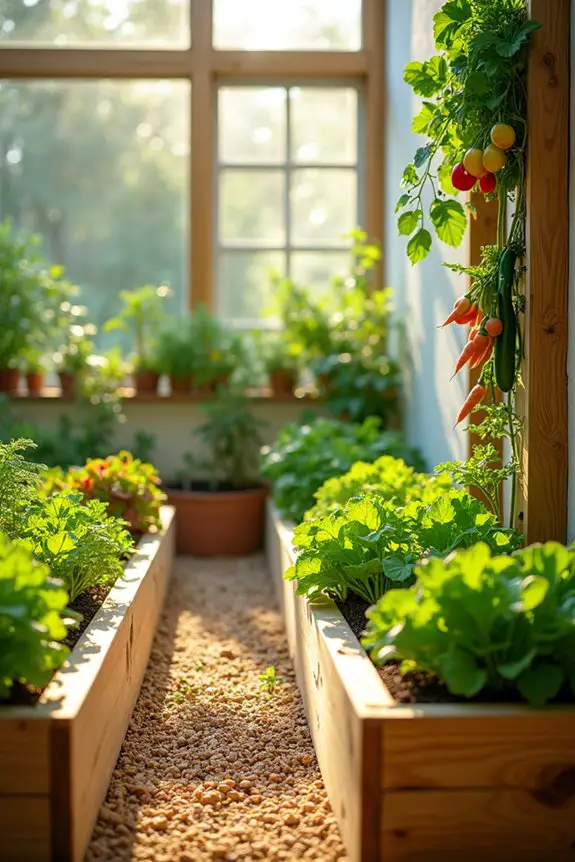
When it comes to designing your indoor vegetable garden layout, the arrangement of your garden beds can make all the difference. Not only does a well-planned layout help maximize your growing space, but it also allows for easy access and a beautiful visual display. And let’s be real, who doesn’t want their kitchen to look like a mini paradise of fresh veggies?
Start by plotting your garden bed locations. Wooden raised beds are a fantastic choice because they provide excellent drainage and keep the soil loose and fluffy—perfect for carrots or anything with a root, really. Additionally, incorporating a solar garden shower can enhance your outdoor gardening experience by providing refreshing water right where you need it.
Think about sunlight, too; some veggies love a lot of it, while others prefer a bit of shade. Position your sun-seekers, like peppers and cucumbers, in the sunniest spots, while leafier greens can chill out in partial shade.
When it comes to size, simplicity is key! If you can comfortably reach the middle from either side, your plants will thank you. Use paths of wood chips or straw to keep your feet and your plants happy. Not only do they suppress weeds, but they also create a charming pathway—imagine strolling through your own veggie wonderland.
Don’t forget to mix it up! A vertical trellis can elevate plants like beans and peas, saving space and giving your garden a tall, lush look. Pair these with trailing plants like cucumbers to create a gorgeous cascade. It’s like living art, except it’s food, and you can eat it.
Keep in mind that as things grow, your indoor vegetable garden will evolve. Morning glories of your planning will soon turn into a garden discovery—something new will always pop up, and you might just find yourself talking to those little green warriors.
To protect your plants from unpredictable weather changes, consider investing in garden plant covers, as they can provide essential protection during seasonal transitions.
Yes, talking to your plants is a thing, and don’t worry, I won’t judge you for it.
3. Garden Layout Planning Essentials
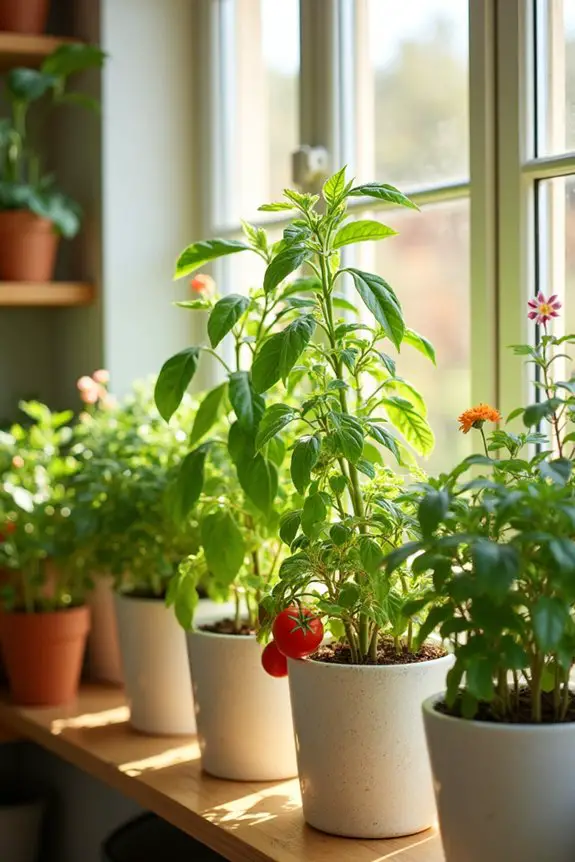
When planning your indoor vegetable garden layout, think about incorporating self-watering planters. Not only do they take a load off your shoulders—no more daily watering ballet—but they also keep your plants happy and hydrated. Imagine being able to focus on your veggies while these smart planters work their magic, allowing you to enjoy a thriving garden without the constant upkeep.
To get started, choose the right size planters to fit your available space. Do you have a cozy nook or a full sunny windowsill? Measure your area first, then select planters that can hold a good number of plants without overcrowding them. You wouldn’t want to throw a wild party in a small apartment, right? Same goes for your plants.
Now, fill those planters with quality potting mix—aim for a fluffy, light blend that drains well. Think of it as giving your plants a comfy bed to lie down in. Then, fill the reservoir according to your planters’ instructions, ensuring those roots can sip water when they’re thirsty. What’s really neat is that with the right positioning—like a sunny spot for your peppers and cucumbers—you can leave them to their own devices, all while basking in the beauty of manageable garden bliss. Additionally, consider that self-watering planters can significantly reduce water waste, promoting efficient water usage for your indoor garden.
And speaking of beauty, don’t forget to decorate your planters. A little splash of color or some fun garden markers can turn your space into a vibrant masterpiece. Wanna take it up a notch? Combine your self-watering planters with vertical gardening techniques. You can easily stack them or place them on shelves, creating a dynamic garden display that not only saves space but also fills your home with life.
In the end, you’ll find joy in your indoor veggie garden—not just in the fresh harvest, but in the process itself. Isn’t it nice to know that with just a bit of planning, you can cultivate a flourishing oasis right in the comfort of your own home?
4. Plant Selection for Vertical Spaces
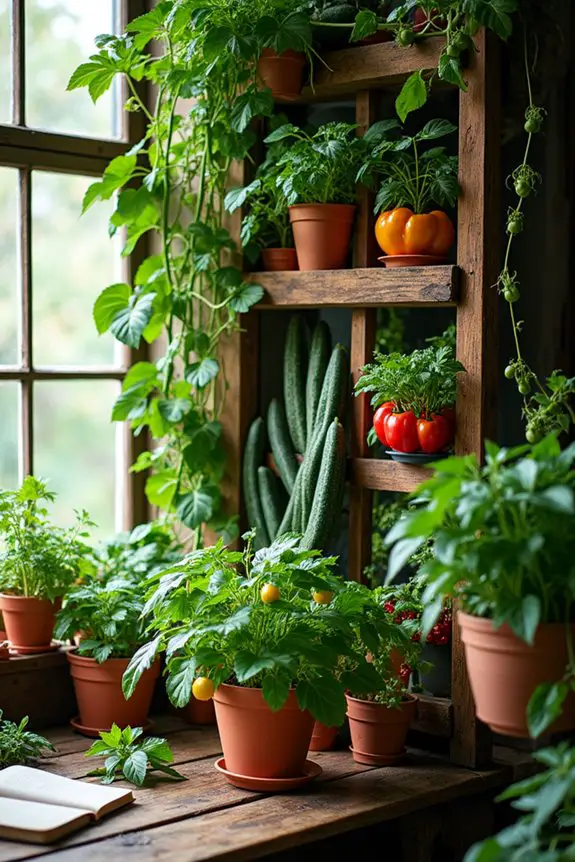
When it comes to vertical gardening, the right plant selection can make all the difference. Not only does it optimize space in your indoor veggie garden, but it also brings an aesthetic charm that transforms your walls into a lush, green haven. Imagine walking into a room adorned with climbing beans and vibrant peppers, all draping elegantly from shelves or trellises—it’s like a living piece of art that feeds you, too.
First things first, think about the climbers that thrive indoors. Peas and beans are fabulous choices—these guys love to stretch and climb, making them perfect for vertical spaces. Pair them with some vibrant cucumbers, which not only grow upward but add a lush, hangy look to your setup.
The whimsical nature of these plants can’t help but lighten your mood, especially when you spot those little tendrils wrapping around something they shouldn’t be. Who knew vegetables could have such personality?
Next, consider the support for your vertical garden—this is where the fun begins. Use simple trellises or even repurpose some old wooden crates to create unique climbing structures. Want a budget-friendly option? Straps or strings attached to the walls can do the trick.
Just be creative and let your plants’ personalities shine! There’s nothing like peeking at your busy little plants and feeling a warm sense of pride, knowing you played a hand in their upward journey.
And while we’re at it, don’t forget herbs. Basil and mint can join the party too. They may not climb as much, but they add bright pops of color and delightful scents that make your garden feel ultimately cozy.
Plus, who wouldn’t want fresh basil at their fingertips for a last-minute pasta sauce? It’s the kind of magic that has your taste buds dancing.
In the end, selecting the right plants for your vertical spaces creates a functional garden that’s a joy to behold. With the right combination of climbing veggies and herbs, your indoor garden can be a splash of growth and color that keeps giving.
And as you watch those plants reach up towards the light, you might just find your heart soaring right along with them. So snag those peas and cucumbers, and let the climbing begin—it’s time to elevate your indoor gardening game.
5. Garden Feature Accessibility Design

When it comes to designing an indoor vegetable garden, accessibility matters. Not only does it keep your plants thriving, but it also creates a welcoming vibe that encourages you to get in there and enjoy the process. Imagine being able to reach every delicious pepper or fragrant basil plant without having to pull a muscle. Sounds dreamy, right? Let’s talk about how to make that dream a reality.
First off, think about where your garden will go. Is it a sunny windowsill or a corner of your kitchen? Make sure the space you choose gets plenty of light. You want those veggies stretching towards the rays, not squirming in the shadows. Plus, arranging your plants by height can add a lovely dimension to your garden. Taller plants like cucumbers or beans should take center stage while shorter herbs like thyme and basil can cozy up in front. It’s like a little plant family portrait—everyone gets their moment to shine.
Next, consider the layout of your planters. If you’re using shelves or multi-tiered stands, keep the most frequently used herbs and veggies at a level that’s easy to reach. No one likes having to perform acrobatics to grab a handful of fresh parsley—trust me, it’s not as fun as it sounds. A simple system, like designated top, middle, and bottom rows, not only creates a neat look but makes sure your culinary heroes are always ready for action.
Speaking of action, remember the joy of cozying up to your plants. Create a little walking path between your garden containers. Even if it’s just a narrow space, it makes it feel less like a jungle gym and more like a free-spirited adventure. It’s funny how gardens can become little sanctuaries. Sometimes, a quick stroll through your leafy oasis can make all the difference on a stressful day.
Lastly, think about incorporating self-watering planters. These beauties make your life so much easier—less time watering and more time enjoying those homegrown meals. Just imagine barely having to lift a finger while still nurturing those ambitious cucumbers and spicy peppers. It’s like a dream come true.
In closing, designing an accessible and functional indoor vegetable garden doesn’t just serve a purpose. It enhances your home, creates a fun little activity space, and makes you feel like a food-growing genius. So, roll up those sleeves, choose your spot wisely, and get ready to dig in. Your veggies are waiting, and trust me, they can’t wait to grow.
6. Pollinator-Friendly Plant Placement
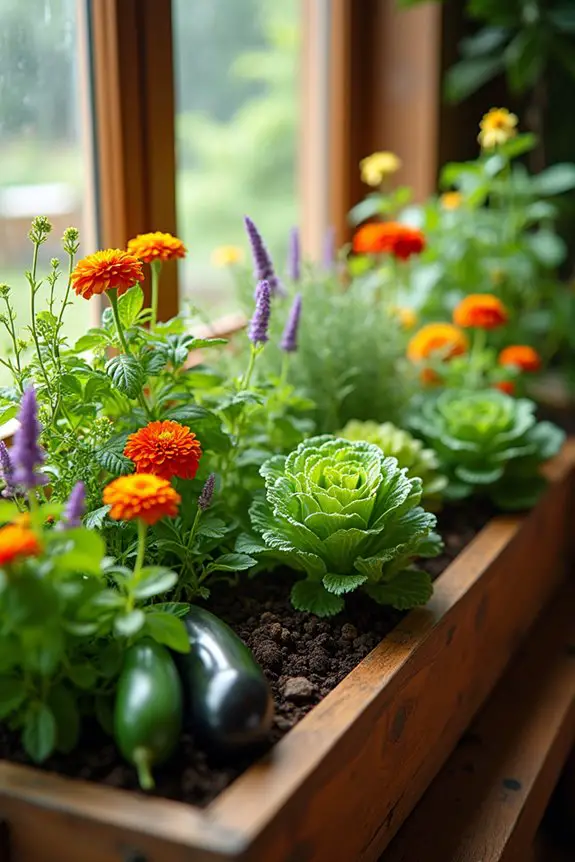
When it comes to creating an indoor vegetable garden, incorporating pollinator-friendly plants into your layout can create a thriving little ecosystem right in your home. Not only do these plants help attract beneficial pollinators, but they also add beauty and vibrant colors to your space, making your indoor garden feel alive and welcoming.
So, how can you seamlessly integrate these delightful plants into your indoor setup? Start by selecting a mix of flowers and herbs that are known to be bee and butterfly magnets. Think about vibrant marigolds, cheerful nasturtiums, and aromatic lavender. Position them strategically among your veggie plants—picture a bright splash of color next to your pepper or basil. This not only draws in pollinators but also gives your garden an appealing, garden-fresh look that makes you feel like a botanical wizard.
As you lay out your garden, consider height and spacing. Place shorter, bushy pollinator-friendly plants near the front or in the middle, allowing taller veggies like cucumbers or eggplants to rise majestically at the back. It’s like directing a colorful play—every plant is a character in your story, and you want each one to shine. Plus, this design creates a lovely visual balance!
And let’s not forget the benefit of outsmarting pests. Healthy pollinator plants can help maintain a balanced ecosystem by attracting predators that munch on those pesky aphids trying to invade your lettuce. It’s like having little garden bouncers keeping the riff-raff at bay. Doesn’t it feel great to know that your garden isn’t just beautiful, but also working hard to support its inhabitants?
Lastly, make sure you have a nice walking path between your plants. This encourages gentle strolls to admire and pick your fresh herbs while giving you easy access to everything in bloom.
Trust me, there’s something meditative about walking through your garden, deciding whether to whip up a stir-fry or sprinkle some fresh basil on your spaghetti.
7. Pathway Layout for Easy Access

When you’re designing your indoor vegetable garden, one super effective tip is to lay out pathways that not only look great but also offer easy access to all those lovely green goodies you’ve planted. Imagine this: walking through your little indoor paradise, the smell of fresh basil fills the air, while your fingers dance gently over the leaves of your thriving peppers. Nice, right?
To create these paths, think about the layout that works for your space—because trust me, tripping over pots isn’t the vibe we’re going for. Start by considering the size of your plants and their growth patterns. You don’t want to be doing acrobatics just to reach a cucumber hiding in the corner.
Leave enough space between rows for easy movement; gauge around 2 to 3 feet is a good rule. This way, you can stroll confidently while picking herbs or checking on your beans without feeling like a Cirque du Soleil performer.
Now, how about adding a sprinkle of style? Lay down some mulched pathways using straw, bark, or wood chips between your veggie sections. Not only do they suppress weeds and keep the soil moist, but they also provide a lovely natural look.
Plus, when you’re sweeping your path, it will look like you’ve got this whole gardening thing under control, even if your last batch of tomatoes turned out more like little green rocks.
Think about lighting, too. Position your plants where they can bask in the glow of the sun, but make sure your paths get enough light so you can see where you’re walking. Overhead grow lights can come in handy here. It’s like giving your garden an all-star lighting crew, making everything pop.
Lastly, don’t forget about that personal touch. Maybe add a cozy chair or a little bench where you can sip on some herbal tea and admire your masterpiece.
It turns your indoor garden from just a food source into a tranquil retreat, a place where you can feel one with nature—well, at least as close as you can get while still in your pajamas and indoors.
8. Seasonal Color Scheme Integration
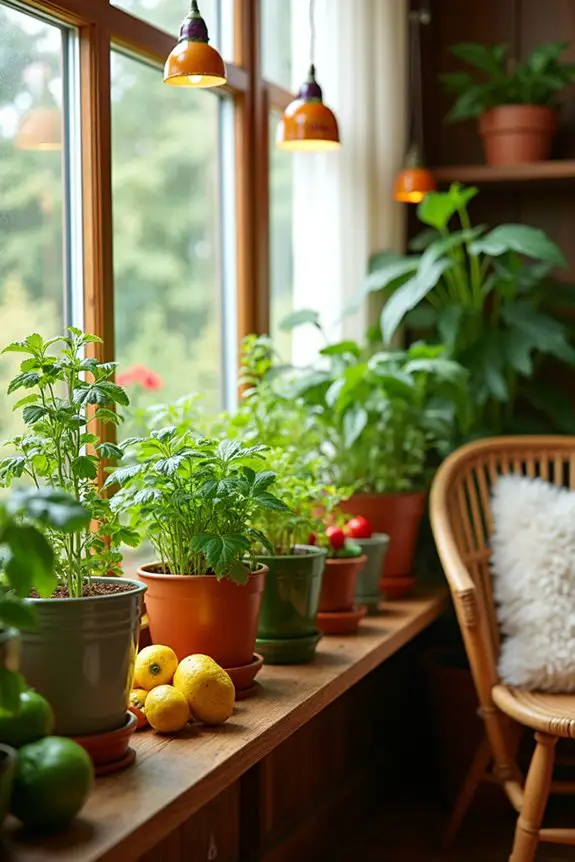
When crafting your indoor vegetable garden, consider using a seasonal color scheme to elevate both the aesthetic and functionality of your space. Not only does this help with organization, but it also brings a vibrant energy to your little green haven, making it feel genuinely inviting. Imagine walking into your indoor garden and being greeted by all the beautiful hues of fresh veggies and herbs; it’s hard not to smile, right?
Start by choosing a main color palette. For a revitalizing spring vibe, think of greens and yellows, pairing those luscious basil leaves with bright yellow cucumbers. In summer, you can add pops of red from your peppers to mix things up. And don’t forget the rich purples of eggplants, providing a stunning contrast against the already lively greens. By doing so, you create a visual feast that’s as appealing to the eyes as it’s to the taste buds.
Now, let’s get organized. Use smaller pots for herbs and quick-growing veggies, like basil and beans, placing them at eye level so they can steal the spotlight. Larger plants, such as cucumbers and peppers, can stand proud in the back or on taller shelves, creating depth in your layout. You see, the layout and color coordination here aren’t just for show—they help guide your gardening efforts, making it easy to discern how much space each plant needs and where to direct your care.
Consider accessorizing your space as well. A simple decorative pot or a vibrant plant marker can tie the whole look together without feeling cluttered. I tried using mismatched pots once, thinking I was adding “personality,” but it made my garden look like a yard sale explosion instead. So, learn from my amusing mishap: aim for synergy in your pot selection while adding some personal flair.
And lighting? It plays a huge role here too! Position your colorful veggie arrangements where they can soak up natural sunlight, but also consider adding some warm, strategic lighting to highlight those fabulous colors. Overhead grow lights can shine a spotlight on your masterpieces, literally turning your garden into a cozy, Instagram-worthy nook.
9. Colorful Container Arrangements
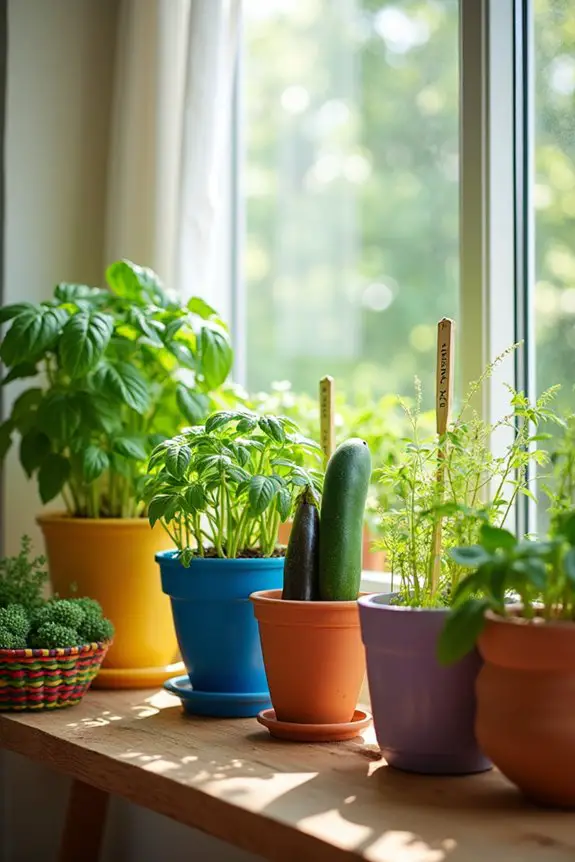
When it comes to arranging your indoor vegetable garden, color coordination can be a game changer. Not only does it elevate the aesthetic appeal, but it can also improve the functionality of your space. Imagine the cozy corners filled with greens, reds, and purples. It’s like having a little piece of nature right in your home, waiting to brighten your day.
Start by choosing vibrant containers that pop against your walls. Maybe a royal blue pot for that bushy basil, or a sunny yellow one for your cheerful cucumbers. Think of it as setting up your very own veggie stage where each plant gets its moment in the limelight.
I once made the mistake of sticking all my plants in boring black pots. It felt more like a plant jail than an indoor paradise. Lesson learned: let your pots shine!
Next, arrange plants not only by color but by height and growth habits. Place the tall cucumbers in the back, climbing high, while those charming little beans and herbs can dance in front. It gives your garden depth and makes it easier to care for each plant. When I finally got this arrangement right, it felt like I’d transformed my living room into a botanical wonderland—until my cat thought it was a jungle gym.
Now let’s not forget about the spacing. This is essential. While colorful, tightly packed arrangements might look enticing, you want to avoid overcrowding. Each plant needs its space to grow and breathe. When I squished my eggplant in next to my peppers just because they matched, I ended up with sad, stunted plants. Not pretty. Aim for just enough room for growth without losing that lively look.
To keep the vibes flowing, consider rotating your containers occasionally. It can refresh the look and prevents some plants from leaning toward the sun too much. Trust me, I’ve tried to resurrect a few sad, tilted plants that were aiming for the nearest window. If only they put half as much effort into growing as they did in leaning.
Lastly, accessorize a bit. Perhaps some cute wooden plant markers or colorful coasters can enhance your arrangements. Just remember, keep it simple. I went overboard once and ended up with a colorful chaos that looked more like a toddler’s art project than a stylish garden.
So, embrace your creative spirit, but know when to dial it back.
With these tips in mind, you can create a vibrant, functional indoor vegetable container garden that not only suits your kitchen aesthetic but also brings joy every time you pass by. Now, get ready to enjoy nature’s beauty right at home—unless, of course, you have a curious pet. In that case, good luck!
10. Garden Feature Aesthetic Harmony
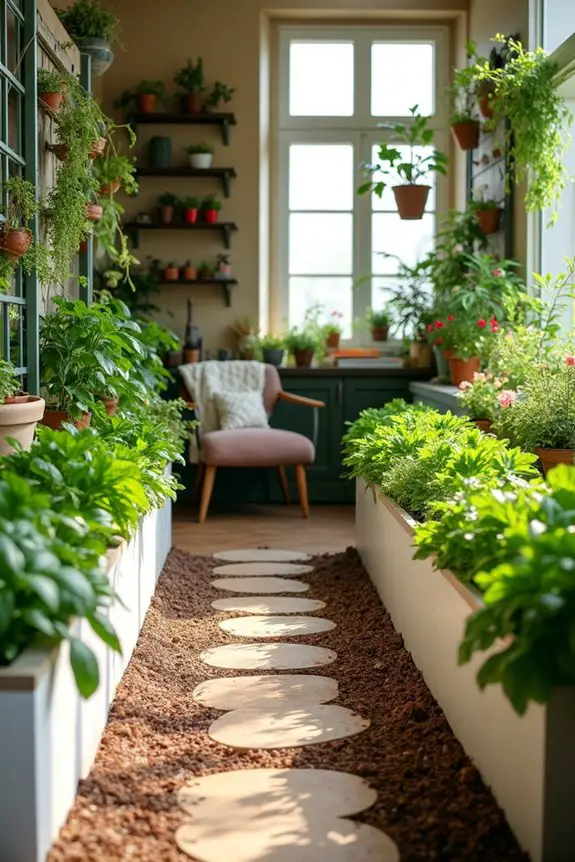
Creating a beautiful indoor vegetable garden layout isn’t just about the plants—it’s about creating a harmonious space that feels just right. Choosing the right features for your garden can transform your indoor area into a lively oasis, balancing both function and aesthetics. Imagine fresh basil waiting on your kitchen counter, or vibrant peppers catching the eye as you walk by. It’s like having a mini farmer’s market right at home!
First, think about vertical trellis gardens. They’re perfect for climbing veggies like beans and peas, adding height and interest to your setup. Besides, who wouldn’t want a peek of green reaching up toward the ceiling? It opens up the space, making your room feel larger and you? A proud gardener with a flair for creativity. I remember my first attempt at this—let’s just say I had a mini jungle on my hands. Lesson learned!
Next, consider the power of self-watering planters. They keep your plants hydrated with little effort, letting you reap the benefits of a green thumb even if you sometimes forget to water. You know what I mean; life gets busy, and plants can’t always be your priority. So, I splurged on a couple of these beauties after learning the hard way that my poor basil was wilting away as I binged another show. They really do help strike that perfect balance between looks and practicality.
Now, think pathways—yes, even in your indoor garden. Use mulched pathways to line your rows of potted plants. This not only looks charming but keeps the soil moist and prevents dirt from getting all over the place when you’re checking on your ripening tomatoes. It creates clear paths for you to “proudly showcase” your little harvest, enhancing both the feel and function of your space. You’ll be the envy of all your friends—not to mention, part-time gardener.
Lastly, don’t forget about the little touches that bring a space together. Decorative plant markers can add a whimsical flair while helping you remember what’s what. Nothing worse than spending weeks nurturing a plant only to forget its name (been there). I made my own once—let’s just say they were a bit too artistic. Quick tip: stick to simple labels that are easy to read and blend well with your color theme.
Companion Planting Strategies
While you might think growing your veggies is all about sunlight, water, and good soil, you can’t overlook the magic of companion planting. Imagine putting basil next to your tomatoes; they’ll help each other grow, and you’ll have fresh pesto on hand.
When brainstorming veggie garden ideas, think about pairing carrots with onions—those pesky flies can’t stand those scents. You don’t have to be a master gardener to dabble in this art. Just ask yourself, “Which flavors do I enjoy together?”
Mix marigolds into your rows; they repel harmful pests. It’s like having a best friend for your plants. Who knew gardening could feel so social?
Immerse yourself in companion planting, and your veggie garden will thrive with a little teamwork.

